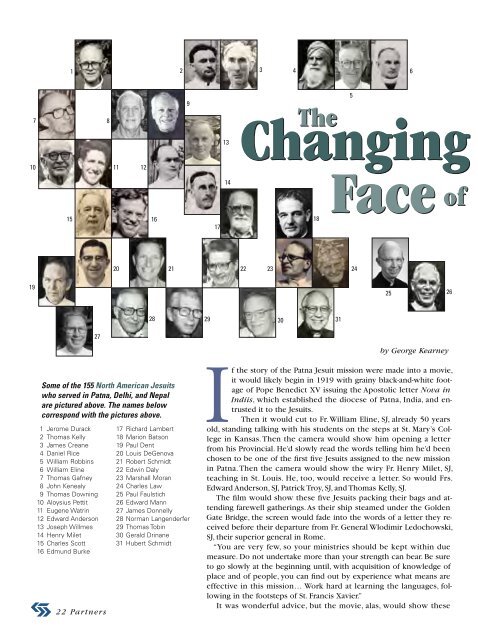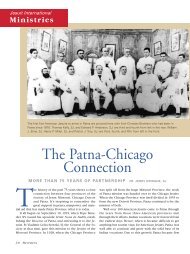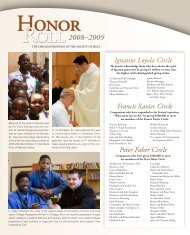SP05 PARTNERS fin2.indd - Chicago-Detroit Province
SP05 PARTNERS fin2.indd - Chicago-Detroit Province
SP05 PARTNERS fin2.indd - Chicago-Detroit Province
You also want an ePaper? Increase the reach of your titles
YUMPU automatically turns print PDFs into web optimized ePapers that Google loves.
1 2 3 467 8913The5Changing10 11 1214Faceof15 16171820 21 22 23 241925 2628 29 30 3127Some of the 155 North American Jesuitswho served in Patna, Delhi, and Nepalare pictured above. The names belowcorrespond with the pictures above.1 Jerome Durack2 Thomas Kelly3 James Creane4 Daniel Rice5 William Robbins6 William Eline7 Thomas Gafney8 John Kenealy9 Thomas Downing10 Aloysius Pettit11 Eugene Watrin12 Edward Anderson13 Joseph Willmes14 Henry Milet15 Charles Scott16 Edmund Burke22 Partners17 Richard Lambert18 Marion Batson19 Paul Dent20 Louis DeGenova21 Robert Schmidt22 Edwin Daly23 Marshall Moran24 Charles Law25 Paul Faulstich26 Edward Mann27 James Donnelly28 Norman Langenderfer29 Thomas Tobin30 Gerald Drinane31 Hubert Schmidtby George KearneyIf the story of the Patna Jesuit mission were made into a movie,it would likely begin in 1919 with grainy black-and-white footageof Pope Benedict XV issuing the Apostolic letter Nova inIndiis, which established the diocese of Patna, India, and entrustedit to the Jesuits.Then it would cut to Fr. William Eline, SJ, already 50 yearsold, standing talking with his students on the steps at St. Mary’s Collegein Kansas. Then the camera would show him opening a letterfrom his Provincial. He’d slowly read the words telling him he’d beenchosen to be one of the first five Jesuits assigned to the new missionin Patna. Then the camera would show the wiry Fr. Henry Milet, SJ,teaching in St. Louis. He, too, would receive a letter. So would Frs.Edward Anderson, SJ, Patrick Troy, SJ, and Thomas Kelly, SJ.The film would show these five Jesuits packing their bags and attendingfarewell gatherings. As their ship steamed under the GoldenGate Bridge, the screen would fade into the words of a letter they receivedbefore their departure from Fr. General Wlodimir Ledochowski,SJ, their superior general in Rome.“You are very few, so your ministries should be kept within duemeasure. Do not undertake more than your strength can bear. Be sureto go slowly at the beginning until, with acquisition of knowledge ofplace and of people, you can find out by experience what means areeffective in this mission… Work hard at learning the languages, followingin the footsteps of St. Francis Xavier.”It was wonderful advice, but the movie, alas, would show these
1 2Jesuit InternationalMinistries3 4 569 10 11128Patna713 1415 1617<strong>Province</strong>18 192021302829222324five Jesuits recklessly disregarding Fr. General’s words and pursingtheir apostolic work with seemingly boundless energy after their arrivalin 1921.The movie would show how 155 Jesuits over the years, most fromthe <strong>Chicago</strong> and <strong>Detroit</strong> <strong>Province</strong>s, served the people of Patna byopening parishes and schools, and how their reputation as educatorscaused the Diwan of Jaipur, hundreds of miles west of Patna, to invitethem to open a school there. And it would include footage of theKing of Nepal inviting Fr. Marshall Moran, SJ, and a group of pioneeringJesuits into the once-cloistered mountain kingdom to openschools.Unfolding this panorama, the movie would show a substantial increasein the number of Catholics in India and steady growth in thePatna Mission until, in 1962, it became an independent <strong>Province</strong> ofthe Society of Jesus. It would show the Jesuits expanding into Delhiand diversifying their ministries until both Nepal and Delhi becameseparate regions of the Society of Jesus.The movie would undoubtedly show Jesuits like Frs. James Creane,Henry Westropp, Marion Batson, John Morrison, Joe Mann, and TonyGrollig reaching out to the Dalits, those of the lowest caste—oftendeemed “untouchable”—in India, serving them and respecting theirdignity as human beings in a way that few others ever had. The filmwould show Khrist Raja High School, founded in 1927, the St. Xavierschools in Patna, Nepal, Delhi and Jaipur, Ara Catholic High School,and St. Michael’s School (which was founded by the Capuchins, run252627Some of the hundreds of Native Indianswho have served in Patna, Delhi, andNepal since the Society of Jesus arrivedin the region in 1921. The names belowcorrespond with the pictures above.1 Benedict Osta2 Hilary Goveas3 Jacob Vellaringatt4 Ignatius Vellaringatt5 Joseph Mannaravelil6 Abraham Thannikapara7 Benny Moolan8 Sushil Sah9 Joseph Vellaringatt10 Mario James11 William D’Souza12 Abraham Puthamana13 Francis Palliparambil14 Thomas Anthonysamy15 Vinal Kishore16 Anthony Pendamath3117 Daniel Raj18 John Ariapilly19 Cyriac Poovkot20 Joseph Parekkattil21 Martin Poras22 Jose Kunjaparambil23 Varkey Perkkatt24 Mathew Assarikudy25 Tony Dias26 K.M. Joseph27 MM Matthew28 Gabriel Michael29 Pius Osta30 George Karama31 Gregory Gomes32 Jose KalapuraPartners 2332
Why Give toPatna <strong>Province</strong>?Many generous donors from the <strong>Chicago</strong> <strong>Province</strong>were drawn to Patna and Nepal becauseof personal relationships with Jesuits stationedthere. Many of those Jesuits are now gone. Butthe donors continue to be generous to Patna andNepal. Why? We asked some of them and here’swhat they said.Rosemary McNeeve andMathew Assarikudy, SJ,Nepal region superior.Christopher Fussner,a Singapore-basedbusinessman, maintainsclose ties with Jesuits inPatna and Nepal.Charlie Mann with GeraldGrace, SJ, who served fordecades in Patna.24 PartnersRosemary McNeeve“My sister and I havedonated to Patna inmemory of our brother,Frank McNeeve, SJ,who was a Jesuit scholastic.He wanted to domissionary work butdied before he could gooverseas. The Jesuits inIndia today are called byGod just the same asthe Jesuits from here.”Christopher Fussner“I first went to Nepalin 1973, and becamefriends with Fr. GeneWatrin, SJ, who diedlast February. I’ve beenfunding the mobilemedical clinic in Nepalfor over ten years andwill continue to expandthis project. I’ve workedwith the Jesuit team inNepal for years and amexcited that they seekto continue the work Fr.Watrin started.”Charlie Mann“The answer, for me, issimple. This is what wassupposed to happen.From the day my uncle,Fr. Joe Mann, SJ, arrivedin India in 1928, thiswas the plan, to havethe people of India takeover the Church. It’s theirChurch now. It’s not aforeign Church. I believethat’s God’s plan.”by the Irish Christian Brothers,and handed over to theJesuits in 1968) all run by theJesuits, growing to becomesome of the best and mostprominent schools in Indiaand Nepal. The Jesuits runningthese schools have, overthe years, continued to reachout to the poor, always makingspace for them in theirschools.The movie would showthe Jesuits opening collegesin Patna and Nepal. It wouldshow them creating numerousnon-formal initiatives supporting rural education and development,and a variety of vocational programs. Also included would bethe various communications initiatives and the many retreat housesopened to share the Spiritual Exercises of St. Ignatius with the peopleof India. The movie would show scenes of Frs. Gene Watrin, SJ, andJim Donnelly, SJ, teaching in Nepal, and Fr. Watrin and Fr. Lud Stiller,SJ, urging the graduates of Nepal’s Godavari school to reach out to thepoor living in their midst through the Godavari Alumni Association. Aheroic and tragic scene would show Fr. Tom Gafney, SJ, ministeringto young men and women suffering from physical maladies and substanceabuse. Included, too, would be scenes of Fr. Gafney challengingthe drug dealers in Kathmandu, likely the same ones who enteredhis small bedroom in the middle of the night and killed him in 1997.The Ending (and Beginning)The final scene of the movie could’ve been filmed in summer 2004when first and second-year novices, from far-flung parts of the Patna<strong>Province</strong> and even from other parts of India, gathered at Xavier TeachersTraining Institute, Patna’s Jesuit novitiate. For the first time, thenumber of novices in the Patna <strong>Province</strong> outnumbered the Jesuitsfrom North America still serving in Patna, Delhi, and Nepal. As of thisfall, there were 23 native Indian novices, and 18 Americans.The future of the Patna <strong>Province</strong> is Indian. At some point in the nottoo-distantfuture there won’t be any more Jesuits from the UnitedStates serving in Patna.To the many families and friends of the Patna Jesuits, in the Midwestand around the world, who have long supported the work ofthe Patna Jesuit Mission, this may seem a sad end to the story. Foryears, folks in <strong>Chicago</strong>, Cincinnati, <strong>Detroit</strong>, and Cleveland watchedas their friends, brothers, and sons volunteered for assignments toPatna. These Jesuits walked away from everything they’d ever known,motivated by some combination of a thirst for adventure, faith in God,and a desire to serve.Folks at home watched with wonderment and pride as these Jesuitswere able to build schools, churches, a province, and a pair of regions.The folks at home waited anxiously for updates, which in thepre-e-mail days arrived in bent and battered blue and brown air mailenvelopes. They sent letters back and did what they could to supportthe work taking place on the other side of the world. These familyand friends gathered often to pray for the Patna Jesuits. They raisedmoney. They raised awareness. It was, in many ways, their mission.So to some of them this may seem a sad end to the story.
For many years, missionaries from the Americas and Europe outnumbered native vocations.But, as evidenced by this photo of a recent Patna <strong>Province</strong> congregation, the work of thosemissionaries has inspired many native Indians to become Jesuits.“But,” says Fr. Jerry Drinane, SJ, who left the <strong>Chicago</strong> <strong>Province</strong> forPatna in 1954, “it’s a perfect ending, it’s a happy ending.”From the earliest days of the Patna Mission, the American Jesuitsthere realized the need to foster native vocations. Fr. William Eline’sfirst ministry, in addition to serving as superior of the mission, involvedserving as a chaplain to the British Troops and teaching at aschool that had been established years earlier by Irish Christian Brothers.In the books We Band of Brothers: Volumes I and II, Fr. Jim Cox,SJ, who wrote brief biographies of many of Patna’s Jesuits after theirdeaths, said teaching at the school was a job Fr. Eline “relished, forit would bring vocations to Patna Mission. Later he was very happywhen three students from there became Jesuits.”In many ways, that was the beginning of the Patna Mission. Fromthe outset, there was an understanding that the Patna Mission belongedto the people of Patna, not to the white-cassocked missionarieswho had traveled there from different parts of the world. Eventually,the Jesuits hoped, the Mission would be populated not by Americansalmost exclusively, but by native vocations.Today Jesuits from the United States make up only a fraction ofthe Patna <strong>Province</strong>, which now numbers 413 members. Many of theJesuits in Patna came from other parts of India. A substantial numberhail from Kerala, in southern India, where St. Francis Xavier and St.Thomas the Apostle had an enormous influence that’s evidenced stilltoday by a sizeable Catholic population. But 102 members of the <strong>Province</strong>are from Bihar, the state in Northern India where Patna <strong>Province</strong>is located, and 42 are graduates of Jesuit schools. Each undoubtedlywas inspired to pursue a life of service by a Jesuit. It may have beena Jesuit from the States, or a younger Indian Jesuit who was inspiredby his American teachers.And that’s where the story ends, with a vibrant <strong>Province</strong> that continuesto inspire native vocations. The 18 North American Jesuits stillin Patna couldn’t have hoped for a better ending to their story. Themany ministries they and their predecessors helped create will continueto serve the people of Patna. The only thing changing is thecolor of the skin of the teachers, spiritual directors, and missionaries.They are today’s Patna Jesuits. And their American predecessors, thefirst Patna Jesuits, couldn’t be happier. In fact, this is all they everwanted. ■These Jesuits from North America arecurrently serving in Patna, Delhi, and Nepal.The years to the right of their names mark theyear of their arrival in the region.Fr. Theodore Bowling, SJ (1951)Fr. Martin Coyne, SJ (1961)Fr. Edwin Daly, SJ (1952)Fr. James Donnelly, SJ (1961)Fr. Gerald Drinane, SJ (1954)Fr. Jerome Durack, SJ (1951)Fr. Charles Fox, SJ (1938)Fr. William Goudreau, SJ (1947)Fr. Anthony Grollig, SJ (1949)Fr. Paul Kehres, SJ (1956)Fr. John Kenealy, SJ (1949)Fr. Richard Lambert, SJ (1961)Fr. Norman Langenderfer, SJ (1948)Fr. Roman Lewicki, SJ (1959)Fr. John Locke, SJ (1958)Fr. Casper Miller, SJ (1958)Fr. William Robins, SJ (1977)Fr. Robert Schmidt, SJ (1964)Fr. Gregory C. Sharkey (1994)Fr. Ludwig Stiller, SJ (1956)Fr. Thomas Tobin, SJ (1961)Though there are a decreasing number of<strong>Chicago</strong> <strong>Province</strong> Jesuits currently in Patna,Nepal, and Delhi, the <strong>Chicago</strong> <strong>Province</strong>continues to maintain extremely close ties,ties that have been formalized in a “convenio”agreement, with Patna. There are, today, manyneeds in the Patna <strong>Province</strong>. Your contributionscan still be used to support the Patna Jesuits asthey continue to serve in the ministries startedby their predecessors. Please use the enclosedenvelope to make a contribution or contact JeffSmart or Mike Murray (at 800-922-5327) fordetailed giving opportunities.





